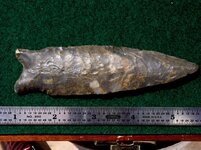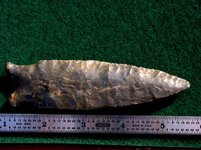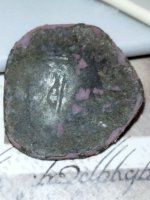spot
Jr. Member
Type: Dalton
Material: Unknown (very heavy patination)
Providence: North East Texas
Note: May be first stage based on size for the area and knapping pattern
Morning,
This Dalton was recovered from a select cut in North East Texas about twenty five years ago. It was published in some archaeological memoir or book of which I have never owned a copy and can't recall the title. It is large for the type and the area in which it was found measuring over 4 1/2 inches. Based on the flaking style and size, I believe this is a first stage form meaning tht it has not had a resharpening since its original fabrication.
Unfortunately, you will note in one photograph that the upper blade edge has a little piece of dark colored modeling clay that I stuck on there when I first had it to fill in a ding that's there. Otherwise, the piece is entirely intact. As you can see, I am no restorer of artifacts...lol. I probably should have sent it off for restoration but I only own maybe three points that are restored.....I just never got into the restoration thing.
Of course Sloan and Pike County varients are longer/larger and also look a little different. For a plain Dalton from this area, it would be considered pretty good sized. It has that good, old and "greasy" feel to it.
Thanks for looking,
spot
Material: Unknown (very heavy patination)
Providence: North East Texas
Note: May be first stage based on size for the area and knapping pattern
Morning,
This Dalton was recovered from a select cut in North East Texas about twenty five years ago. It was published in some archaeological memoir or book of which I have never owned a copy and can't recall the title. It is large for the type and the area in which it was found measuring over 4 1/2 inches. Based on the flaking style and size, I believe this is a first stage form meaning tht it has not had a resharpening since its original fabrication.
Unfortunately, you will note in one photograph that the upper blade edge has a little piece of dark colored modeling clay that I stuck on there when I first had it to fill in a ding that's there. Otherwise, the piece is entirely intact. As you can see, I am no restorer of artifacts...lol. I probably should have sent it off for restoration but I only own maybe three points that are restored.....I just never got into the restoration thing.
Of course Sloan and Pike County varients are longer/larger and also look a little different. For a plain Dalton from this area, it would be considered pretty good sized. It has that good, old and "greasy" feel to it.
Thanks for looking,
spot
Amazon Forum Fav 👍
Attachments
Upvote
0




 Beveling can be a primary or secondary stage sharpening process.
Beveling can be a primary or secondary stage sharpening process. 
 You keep rolling them out. That's a fine point and I'm glad you shared it with us.
You keep rolling them out. That's a fine point and I'm glad you shared it with us. 












